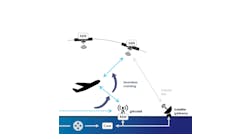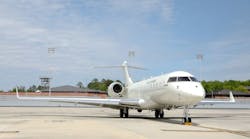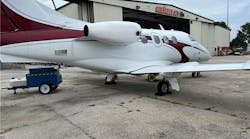The importance of inflight connectivity has accelerated rapidly over the years. While it was once considered a nice-to-have in business aviation, it has now become a must-have, with jet owners and operators needing to facilitate both the productivity and entertainment of their passengers, declares Harry Shadbolt, Global Partner Director for Viasat’s recently acquired Inmarsat business. “We recently published the results from our 2023 survey of business aviation professionals, which revealed almost three-quarters (74%) of respondents noticed passenger satisfaction had significantly increased since IFC was offered onboard their aircraft. As a result, the number of business jets with Wi-Fi installed as linefit or retrofit has skyrocketed and will only continue to escalate," he says.
For many passengers, if the Wi-Fi connectivity is not working, the aircraft is considered AOG and will not fly and it is very important to the passengers flying in executive aircraft, declares Michael Skou Christensen, chief commercial officer of Satcom Direct.
According to Siegfried Axtmann, chair of FAI Group, Wi-Fi installations in business jets are indeed on the rise and various solutions are available for retrofit including ultra-high speed Internet and lower speed solutions. “FAI Technik has garnered extensive experience having performed more than a dozen of these installations, but the ultra-high-speed solutions are currently not available for installation,” he says.
Almost every business jet has some connectivity, and the key point is to understand what the mission of the aircraft is and which connectivity solution best fits with that mission, affirms Adam Sheppard, director of aircraft connectivity at Honeywell Aerospace. “A client who only does email should have a different solution from one that wants to stream video, all the more when one wants to expand the regions in which one flies,” he affirms.
Technical Solutions
Honeywell’s JetWave connectivity system paired with Viasat’s Jet ConneX (JX) Ka-band solution, one of two Ka-band solutions from Viasat, has been activated on more than 1,400 business jets around the world and delivers seamless, high-speed global coverage.
“Since entering commercial service in November 2016, Jet ConneX has been offering the same reliable, consistent, high-speed broadband previously only available on the ground. Passenger usage of Jet ConneX has also increased to record levels since the pandemic, a testament to fast-growing expectations from users, who use their JX service for everything from video streaming and live TV to conference calls and other business activities”, affirms Shadbolt.
Honeywell is also partnering with Viasat to develop an upgrade to existing and future SwiftBroadband (SBB) L-Band connectivity systems, which will allow customers to see a throughput improvement of up to six times faster than what is currently available over L-Band. This upgrade, consisting of a simple box swap, is designed to be frictionless. There is no need to update any wiring on the aircraft or to swap out the radome or antenna. Operators can simply work with their service provider on the best suitable package. “Our SBB L-band connectivity service is currently flying on 4,000 business jets and we are building on that with SwiftJet, a new L-band solution that offers speeds up to six times faster than SBB. SwiftJet will deliver enhanced connectivity for aircraft not equipped with Jet ConneX and reliable back-up capabilities for aircraft that are. As a result, passengers can create a secure ‘office in the sky’, with enhanced capabilities for video calls, web browsing, email, texting, cloud-syncing, and collaboration tools. It is also fast enough to enable social media and video streaming, which was previously challenging over L-band,” says Shadbolt.
As the demand for Wi-Fi in smaller jets has grown, Satcom Direct is working on a series of purpose-built antennas for the business aviation market to meet the industry’s specific requirements. “The SD Plane Simple® antenna series consists of gimbaled and electronically steered antennas that are either tail-mounted (tma) or electronically steered (ESA) and fuselage-mounted. The tma terminal is a compact dish that fits in the radome of mid-sized aircraft and above”, says Skou Christensen. “The SD Plane Simple Ku-band variant is optimized to connect with the Intelsat FlexExec constellation, also dedicated to business aviation, while the Ka-band variant connects with the Viasat Jet ConneX. The ESA antenna is a flat panel with a low profile of just 1.5 inches that mounts on the aircraft fuselage and connects with the OneWeb LEO network of satellites. The ESA will enable more of the smaller jets to access high speed connectivity. The Plane Simple series serves the full range of business aviation. This multi-orbit capability also enables redundancy with some business aircraft owners equipping two or more versions of the antennas."
Each terminal has been designed to minimize invasive installation. Cables connect the antenna to the single SD modem unit/router, (SMU), which can be located in the ‘hell hole’. With just two LRUs, he observes, the compact size, and the capacity to have the box located in the unpressurised part of the aircraft, the options for smaller jets to have high-speed Wi-Fi connectivity is now a real option, affirms Skou Christensen. “This simplicity, hence, the name, also allows for simplified upgrade pathways to keep pace with the rapidly developing technology. The antennas have been future proofed so that they can adapt as the technology advances, this protects the customer investment in the installation”, he says. “The airtime packages and services are tailored to each customer and incorporate competitive fees so that more customers can optimize the benefit of Wi-Fi connectivity."
Installation and Testing
Service providers do not install the equipment directly but they work alongside MRO partners to ensure the terminal is installed correctly and supports the validation of the system performance before the aircraft is returned to the customer. “Our NOC is always observing connectivity and network performance and can anticipate any coverage interruptions and resolve them before the customer even knows. We work closely with our satellite airtime partners, which means we constantly communicate with them to share knowledge about network performance. These strong relations mean we can support them and our customers in delivering and receiving consistent Wi-Fi connectivity”, affirms Skou Christensen. “The support team also works with the MRO to ensure that the equipment works before being handed over to the customer. In addition, to help customers optimise the Wi-Fi, we have a dedicated training team that works with the client to ensure the system’s full capability is accessed; this entry-into-service team will qualify the installation and support the customer usage all the way through the onboarding process. The training can take place at an Satcom Direct site, at the customer or MRO facility, or even on-wing once the system is installed with the flight department”.
With regard to testing when there is an issue, most satellite constellations are available for testing on the ground and, when testing a SATCOM system, most of the time Honeywell’s qualified network support engineers are necessary, affirms Sheppard.
If the system is not functioning as expected, it is almost invariably related to a connectivity outage, and, observes Axtmann, most Wi-Fi installations have self-test functions via apps to make sure the systems are working.
When a piece of equipment requires inspection – which occurs rarely – accessing the SD Plane Simple terminal installation is relatively easy, observes Skou Christensen. “It is worth noting that we rigorously test before we bring any of our software, hardware, or connectivity services to market. We have tested, trialled, and validated equipment on our own aircraft, a Gulfstream G550, and also work with customers to evaluate the equipment in service. This long and thorough testing means that its performance and reliability are already proven when the product comes to market,” he says.




